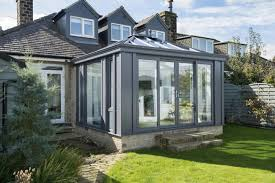A conservatory is a beautiful addition to any home. It extends your usable living space, adds value to your property and brings the outside inside. Designing your new conservatory involves making several design choices. Whether you choose a contemporary or traditional conservatory will also dictate other options like the style of roof you choose. So, what are the different types of roofing styles available?
The Contemporary Conservatory
The clean lines of a lean-to conservatory are the perfect fit for a modern property. A glass roof will allow light to flood in, creating a sense of space that feels very contemporary.
If you want to create a really stunning space, then you might opt for the grandeur of a gable conservatory. Although more usually associated with period properties, the bold design of a gable roofed conservatory can look stunning, combining the light and airy proportions of the glazed walls with the functionality of a tiled roof. For information on installing an Oak Framed Orangery, visit a site like www.timberpride.co.uk/oak-orangery

Traditional
Styles
Victorian or Edwardian-style conservatories make a beautiful addition to a period property. While the Victorian style features a curved geometry, the Edwardian style shares the symmetry of a gable-ended conservatory and really maximises the additional space.
The attention to detail in a period conservatory can work equally well with a glass or tiled roof. If you opt for an orangery, why not incorporate a lantern roof to maximise natural light without compromising a tiled roof?
Tiles for Functionality
Adding a tiled roof to a conservatory has two main benefits. First, it’s in keeping with a more traditional style of conservatory that may feature a gabled or double hipped roof style. Secondly, it adds functionality to the space, allowing you to install insulation for winter use.
However, a tiled roof can be costly and can compromise the amount of light that enters the space.

The Surprising Benefits of Glass
Glass conservatories have a reputation for being roasting in summer and freezing in winter. When you opt for one then you’re not only choosing to let the light flood in, you’re benefiting from the sound- and heat-insulating properties of glass that might surprise you.
Look at options such as self-cleaning glass to cut down on the hassle of cleaning and tinted glass to cut glare. Thermally efficient double-glazed panels will stop heat escaping, allowing you to enjoy the benefits of natural light in your conservatory all year round.